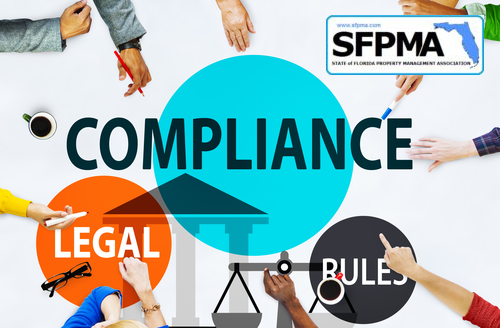FACIAL COVERING REQUIREMENTS COUNTY BY COUNTY & A HAND SANITIZER RECALL
Below you will find face covering requirements for Palm Beach, Broward, Miami-Dade, Hillsborough, Pinellas, Pasco and Manatee Counties. In addition, the cities of Hallandale and Aventura are disucussed.
Where appropriate, face covering requirements for those living in condominiums and homeowners’ associations are discussed as well.
A recall was issued for a certain manufacture of hand sanitizer products which is presented immediately below the face covering information.
PALM BEACH COUNTY
Palm Beach County Order No. 2020-012 provides that effective June 25, 2020, facial coverings are required to be worn in public. Specifically, facial coverings are required to be worn in:
i) Businesses and establishments of any type, including, without limitation, restaurants, retail stores, grocery stores, gyms, indoor recreational facilities and vehicles for hire,
ii) Public places, including outdoor areas that are open and regularly accessible, and outdoor common areas within private communities, where social distancing is not possible or not being practiced,
iii) Palm Tran transit services, and
iv) County and municipal governmental facilities.
Facial coverings are defined under the Palm Beach County Order as any covering which snugly covers the nose and mouth, whether store bought or homemade, mask or clothing covering, including, but not limited to, a scarf, bandana, handkerchief, or other similar cloth covering and which is secured in place. The Order is clear that facial coverings are required to be worn in outdoor common areas within private communities accessible to more than one housing unit where social distancing cannot be accomplished or is not being practiced.
One must also wear a facial covering while working in or visiting businesses and establishments, including indoor recreational facilities.
Businesses and establishments are further required to ensure compliance with the Order and establish a process for verification of compliance upon customer entry into the establishment, and to conspicuously post a specific sign in three languages (CLICK HERE TO LINK-http://discover.pbcgov.org/pdf/covid19/Retail-Mask-Poster.pdf) indicating that persons must wear facial coverings and maintain social distancing.
The Order does not specifically identify indoor common elements or common areas of condominium and homeowners’ associations as businesses or establishments where facial coverings must be worn. However, due to the fact that any type of business or establishment must comply and indoor recreational facilities are specifically listed as establishments in the Order, we believe that the Order likely applies to indoor common element and common area facilities. Therefore, we recommend that you treat your indoor facilities as establishments under the Order until further orders or guidance is provided by the County. This means that associations should monitor and require compliance with facial covering requirements, particularly in indoor recreational facilities, and conspicuously post the designated sign required by the Order.
There are exceptions to the facial covering requirements for certain individuals and in certain situations where they are not feasible, including, but not limited to, by children under two (2), by persons who have medical conditions such as asthma or COPD, and while consuming food or beverages. However, the exceptions are limited and should be implemented in accordance with the Order so as not to cause the spread of the virus. Finally, compliance is serious as the county has now indicated that fines and penalties may be issued for businesses that do not comply. Whether this includes associations is to be determined.
BROWARD COUNTY
Generally, facial coverings must be worn anytime you obtain a good or service from any establishment, including entering, exiting, and otherwise moving around within the establishment (and must be worn by persons working in those establishments during in-person interactions).
The covering should cover the nose and mouth, and comply with the CDC recommendations on the use and sanitation of such coverings. There are certain limited exemptions, including, without limitation, children under the age of two or children of any age while in the custody of licensed childcare facilities, persons with medical conditions, or during the time-period when you are receiving a good/service that precludes wearing a facial covering (e.g., eating, drinking, receiving a facial grooming).
Violations are subject to potential civil penalties (fines) and/or criminal enforcement (2nd degree misdemeanor). Suspected violations can be reported to local municipal code enforcement. The Broward County Order does not specifically require facial coverings within private residential communities (condos/HOAs). Please note, however, that cities may have stricter requirements than the county, so you should confirm with your city accordingly.
Any questions concerning the county requirements can be directed to the County COVID19 Hotline: (954) 357-9500.
The relevant FAQ from the county, and the three (3) Orders are below:
FAQ about Facial Coverings from County: https://www.broward.org/CoronaVirus/Documents/FacialCoveringsFAQs.pdf
EO #12: https://www.broward.org/CoronaVirus/Documents/EmergencyOrder20-12.pdf
EO #13: https://www.broward.org/CoronaVirus/Documents/EmergencyOrder20-13.pdf
EO #14: https://www.broward.org/CoronaVirus/Documents/EmergencyOrder20-14.pdf
CITY OF HALLANDALE
Facial coverings are required within the common areas of all buildings with multiple residents per Emergency Order HB20-12.
CITY OF HOLLYWOOD
All persons beyond legal boundary of residential property are required to wear facial coverings consistent with CDC guidelines as per Emergency Order 2020-06.

MIAMI-DADE COUNTY
Miami-Dade County issued Emergency Order 20-20 on April 9, 2020 (“Order 20-20”) which requires that all persons working in or visiting grocery stores, restaurants, pharmacies, construction sites, public transit vehicles, vehicles for hire, and locations where social distancing measures are not possible to wear facial coverings. In other words, face masks are required where social distancing is not possible. The Order defines a facial covering as “any covering which snugly covers the face and mouth, whether store bought or homemade, and which is secured with ties or ear loops.”
On May 15, 2020, Miami-Dade County issued Emergency Order 23-20 (“Order 23-20”) further providing that anyone “working in or visiting an establishment, including but not limited to airports, seaports, and mass transit facilities and vehicles” must wear a facial covering as described in Order 20-20. However, Order 23-20 provides an exemption for children under the age of two years, persons who have trouble breathing, where federal or state safety regulations prohibit the wearing of facial coverings, and for persons engaged in strenuous physical activity.
On May 27, 2020, Order 23-20 was amended to provide an additional exemption to the facial covering requirement “while persons are eating or drinking.” Additionally, Order 23-20 adopts The New Normal; A Guide for Residents and Commercial Establishments (the “New Normal Guidelines”) which includes industry specific protocols for the reopening of retail and commercial establishments, including general reopening guidelines that provide that facial coverings must be worn inside businesses and commercial establishments or wherever social distancing is not possible.
On June 22, 2020, Mayor Carlos A. Gimenez released a statement regarding the importance of wearing masks and social distancing. He reiterated that masks are required indoors at business establishments and outdoors when people cannot practice social distancing to remain at least six (6) feet apart. In his statement, Mayor Gimenez acknowledged the stricter rules issued by some municipalities in Miami-Dade County, including Miami, North Miami Beach, Aventura, Hialeah, and Miami Gardens.
CITY OF AVENTURA
As pertains to community associations, the City Manager of Aventura issued Emergency Order Number 12 (“Order 12”) which provides additional mandates requiring the use of facial coverings in the interior “Common Areas” of commercial buildings and residential condominium and cooperative buildings. Order 12 provides that common areas include lobby/reception areas, hallways, elevators, mailrooms, clubhouse/meeting rooms, and stair wells. That means that you are required to wear a mask in any interior common areas of condominium or cooperative buildings in the City of Aventura. It is important to note that Order 12 provides that property managers/building managers are required to enforce the facial covering requirement.
HILLSBOROUGH COUNTY
Order 2020-27 went into effect on 5pm June 24, 2020. The order does not specifically apply to community associations as they are not a “business” under the order. Face coverings must be worn inside all indoor establishments. Businesses are required to enforce the mask order and can be charged with a second-degree misdemeanor if they don’t, a penalty of up to 60-days in jail and/or six months’ probation and a $500 fine. The exception does not apply to children under two, persons with pre-existing medical conditions that would be worsened by a mask, hearing-impaired persons, those working in a profession that would be unable to perform their duties with a mask such as public safety, exercising, eating and drinking, or those already observing federal social distancing guidelines (the 6-foot rule).
Tampa is the only exception in Hillsborough where the mask rule would apply to community associations. if you are outside your home, you must wear a face covering and if no face covering, up to a $500 citation could be issued. This would apply to community associations whenever a resident is outside of their residence.
PINELLAS COUNTY
Order 20-14 went into effect on 5pm June 24, 2020. Face coverings must be worn in all indoor public places in Pinellas County. While not specifically drafted to apply to community associations, the definition of indoor public place would cover community associations when the residents can access the facility. The only exceptions applicable to community associations are if less than 10 people are in the facility and they are practicing social distancing. Parties not wearing a mask can receive a civil citation of $100 for a first offense, $250 for a second and $500 for a third. Additional repeat violations may result in a misdemeanor arrest. The exceptions mirror those of Hillsborough County and Pinellas’s enforcement cannot conflict with the Americans with Disabilities Act. The Order does not apply to government entities or hospitals or persons under the age of 18.
PASCO COUNTY
Order went into effect 5pm on June 25, 2020. Face coverings must be worn inside all businesses, government offices, and schools. The definition of businesses is nebulous enough to ensnare community associations under the “providing services to the public” standard. If someone does not wear a mask in the aforementioned places, they will not be able to enter the business, or will be removed once inside. Individual business owners are required to enforce the ordinance or may face a fine up to $250. The exceptions mirrors Hillsborough County and Pasco’s enforcement cannot conflict with the Americans with Disabilities Act. It is suggested you speak with your community association’s attorney due to the lack of specificity in Pasco County’s Order to determine if the Order may apply to your community association.
MANATEE COUNTY
No mask requirements.
HAND SANITIZER RECALL
The Food and Drug Administration issued a warning on nine alcohol-based hand sanitizers manufactured by Eskbiochem SA de CV in Mexico because it contains wood methanol, a toxic substance. It can result in death if ingested or if absorbed through the skin.
“Consumers who have been exposed to hand sanitizer containing methanol should seek immediate treatment, which is critical for potential reversal of toxic effects of methanol poisoning,” the FDA wrote on June 19.”
Following is list of the hand sanitizers manufactured by Eskbiochem:
All-Clean Hand Sanitizer (NDC: 74589-002-01)
Esk Biochem Hand Sanitizer (NDC: 74589-007-01)
CleanCare NoGerm Advanced Hand Sanitizer 75% Alcohol (NDC: 74589-008-04)
The Good Gel Antibacterial Gel Hand Sanitizer (NDC: 74589-010-10)
CleanCare NoGerm Advanced Hand Sanitizer 80% Alcohol (NDC: 74589-005-03)
CleanCare NoGerm Advanced Hand Sanitizer 75% Alcohol (NDC: 74589-009-01)
CleanCare NoGerm Advanced Hand Sanitizer 80% Alcohol (NDC: 74589-003-01)
Saniderm Advanced Hand Sanitizer (NDC: 74589-001-01)

Tags:
Condo and HOA,
Condo and HOA Laws,
Law and Legal,
Management News



 I recently explained how lucky the banks are when they foreclose on a unit or a home and take back ownership. The law protects them, and despite how much the unpaid condo or HOA assessments are, the bank is only responsible for the lesser of one year of assessments or 1% of the mortgage. Many of you are outraged over that and I’m with you.
I recently explained how lucky the banks are when they foreclose on a unit or a home and take back ownership. The law protects them, and despite how much the unpaid condo or HOA assessments are, the bank is only responsible for the lesser of one year of assessments or 1% of the mortgage. Many of you are outraged over that and I’m with you.






 1. Use only legally purchased, approved fireworks. Use them as directed, under supervision and clear of any combustible material and clear of all buildings. Legal fireworks should be used or overseen by a responsible adult. No such fireworks may be thrown into, over, or around other homes, forested areas, or left in the common areas of the HOA. Residents who fail to comply with these restrictions will be held responsible for any damage and repairs.
1. Use only legally purchased, approved fireworks. Use them as directed, under supervision and clear of any combustible material and clear of all buildings. Legal fireworks should be used or overseen by a responsible adult. No such fireworks may be thrown into, over, or around other homes, forested areas, or left in the common areas of the HOA. Residents who fail to comply with these restrictions will be held responsible for any damage and repairs.







 Board members and property managers of condominium communities need to be aware that the State of Florida’s Department of Business and Professional Regulation issued revisions to rules pertaining to violations and penalties,
Board members and property managers of condominium communities need to be aware that the State of Florida’s Department of Business and Professional Regulation issued revisions to rules pertaining to violations and penalties,  SFPMA – State of Florida Property Management Association is an Organization in Florida that Advocates Educates for Members in the Condo, HOA and Property Management Industry. On behalf of our
SFPMA – State of Florida Property Management Association is an Organization in Florida that Advocates Educates for Members in the Condo, HOA and Property Management Industry. On behalf of our 
 Condo owners often complain that their board doesn’t do enough, or that the board members aren’t involved as much as they would like in the administration and maintenance of their building. While a disinterested or apathetic board is certainly a problem, going to the other extreme can be just as bad…or maybe even worse. Board members who let their power go to their heads can be a liability to their building community on many levels, but of particular concern is a board that oversteps its bounds and intrudes on the privacy and agency of individual residents.
Condo owners often complain that their board doesn’t do enough, or that the board members aren’t involved as much as they would like in the administration and maintenance of their building. While a disinterested or apathetic board is certainly a problem, going to the other extreme can be just as bad…or maybe even worse. Board members who let their power go to their heads can be a liability to their building community on many levels, but of particular concern is a board that oversteps its bounds and intrudes on the privacy and agency of individual residents.